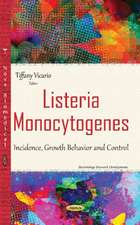Genetics of Bacteria
Autor Sheela Srivastavaen Limba Engleză Hardback – 5 iun 2013
| Toate formatele și edițiile | Preț | Express |
|---|---|---|
| Paperback (1) | 943.43 lei 6-8 săpt. | |
| Springer India – 27 aug 2016 | 943.43 lei 6-8 săpt. | |
| Hardback (1) | 948.92 lei 6-8 săpt. | |
| Springer India – 5 iun 2013 | 948.92 lei 6-8 săpt. |
Preț: 948.92 lei
Preț vechi: 1157.22 lei
-18% Nou
Puncte Express: 1423
Preț estimativ în valută:
181.59€ • 188.51$ • 151.42£
181.59€ • 188.51$ • 151.42£
Carte tipărită la comandă
Livrare economică 24 martie-07 aprilie
Preluare comenzi: 021 569.72.76
Specificații
ISBN-13: 9788132210894
ISBN-10: 8132210891
Pagini: 216
Ilustrații: XV, 200 p. 98 illus.
Dimensiuni: 178 x 254 x 17 mm
Greutate: 0.54 kg
Ediția:2013
Editura: Springer India
Colecția Springer
Locul publicării:New Delhi, India
ISBN-10: 8132210891
Pagini: 216
Ilustrații: XV, 200 p. 98 illus.
Dimensiuni: 178 x 254 x 17 mm
Greutate: 0.54 kg
Ediția:2013
Editura: Springer India
Colecția Springer
Locul publicării:New Delhi, India
Public țintă
ResearchCuprins
Chapter 1.Bacteria and Science of Genetics.- Chapter 2.Gene Mutation—The Basic Mechanism of Generating Variability.- Chapter 3.Conjugation.- Chapter4.Transformation.- Chapter 5.Transduction.- Chapter 6.Plasmids and their Biology.- Chapter 7.Transposable Elements.- Additional Readings.- Index.
Notă biografică
Sheela Srivastava is currently Professor of Genetics at University of Delhi, South Campus, India, where she has been on the faculty since 1984. With her initial training in Botany with specialization in Genetics at Master’s level, she achieved her Ph.D. in biochemical genetics of the fungus, Aspergillus nidulans. The post-doctoral stint in bacterial molecular genetics led to her scientific interest focusing on bacteria. Her major area of research is in genetics of metal-microbe interaction, plant growth promoting characteristics of rhizospheric bacteria, peptide antibiotic production by lactic acid bacteria, and metagenomics. Being associated with the Department of Genetics since its inception, she has served as Head of the Department, Dean, Faculty of Interdisciplinary and Applied Sciences, Chairman, Board of Research Studies, and Chairman, Committee of Courses. She has co-authored two books: Understanding Bacteria (Kluwer Academic Publishers, 2003) and Introduction to Bacteria (VikasPublishing House, 1983) besides co-editing a few volumes. She is currently teaching courses on introductory prokaryotic genetics and advanced course on bacterial and bacteriophage genetics to post-graduate, M.Phil, and Ph.D. students. Her tag line is: “the most challenging job of a teacher in this field is how to make young students learn genetics”.
Textul de pe ultima copertă
Described as the earliest, simplest life forms, with unlimited metabolic versatility, bacteria are ideally suited to answer some very fundamental questions on life and its processes. They have been employed in almost all fields of biological studies, including Genetics. The whole edifice of science of Genetics centers around three processes: the generation, expression, and transmission of biological variation, and bacteria offer immediate advantages in studying all the three aspects of heredity. Being haploid and structurally simple, it becomes easy to isolate mutations of various kinds and relate them to a function. The availability of such mutants and their detailed genetic and biochemical analyses lead to a gamut of information on gene expression and its regulation. While studying the transmission of biological variation, it is clear that unlike their eukaryotic counterpart, a more genetic approach needs to be employed. Transmission of genetic information in most eukaryotic organisms rests on sexual reproduction that allows the generation of genetically variable offspring through the process of gene recombination. Even though bacteria show an apparent preference for asexual reproduction, they too have evolved mechanisms to trade their genetic material. In fact, bacteria not only could acquire many genes from close relatives, but also from entirely distant members through the process of horizontal gene transfer. Their success story of long evolutionary existence will stand testimony to these mechanisms.
While teaching a course on Microbial Genetics to the post-graduate students at Delhi University, it was realized that a book devoted to bacterial genetics may be very handy to the students, researchers, and teachers alike. A strong foundation in genetics also helps in comprehending more modern concepts of molecular biology and recombinant DNA technology, always a favorite with the students and researchers. Planning the format of the book, emphasis has been laid on the generation and transmission of biological variability. The omission of expression part is indeed intentional because lots of information is available on this aspect in any modern biology book. The contents are spread over seven chapters and the text is supported with figures/tables wherever possible. The endeavor has been to induce the readers to appreciate the strength of bacterial genetics and realize the contribution of these tiny organisms to the growth of biological sciences as a whole and genetics in particular.
While teaching a course on Microbial Genetics to the post-graduate students at Delhi University, it was realized that a book devoted to bacterial genetics may be very handy to the students, researchers, and teachers alike. A strong foundation in genetics also helps in comprehending more modern concepts of molecular biology and recombinant DNA technology, always a favorite with the students and researchers. Planning the format of the book, emphasis has been laid on the generation and transmission of biological variability. The omission of expression part is indeed intentional because lots of information is available on this aspect in any modern biology book. The contents are spread over seven chapters and the text is supported with figures/tables wherever possible. The endeavor has been to induce the readers to appreciate the strength of bacterial genetics and realize the contribution of these tiny organisms to the growth of biological sciences as a whole and genetics in particular.
Caracteristici
This book is a survey of the genetics of the bacteria and its mutations, and it provides its readers a comprehensive introduction to this rapidly changing subject The text has been extensively supported by the illustrations to drive home the necessary information Well explained content based on 41 years of research experience of the authors.








